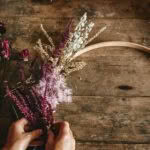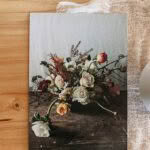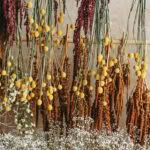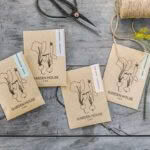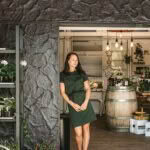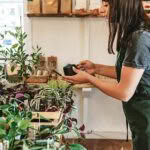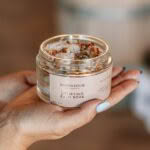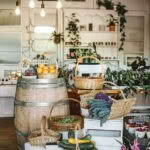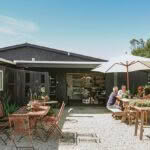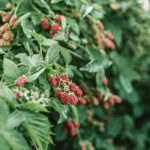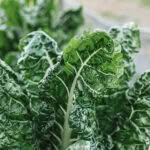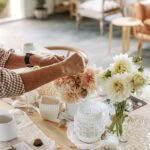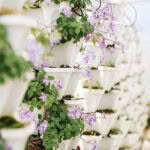From shed to Garden House: This Tasman couple grew an idyllic lifestyle (and many garden-fresh ventures) from ground up
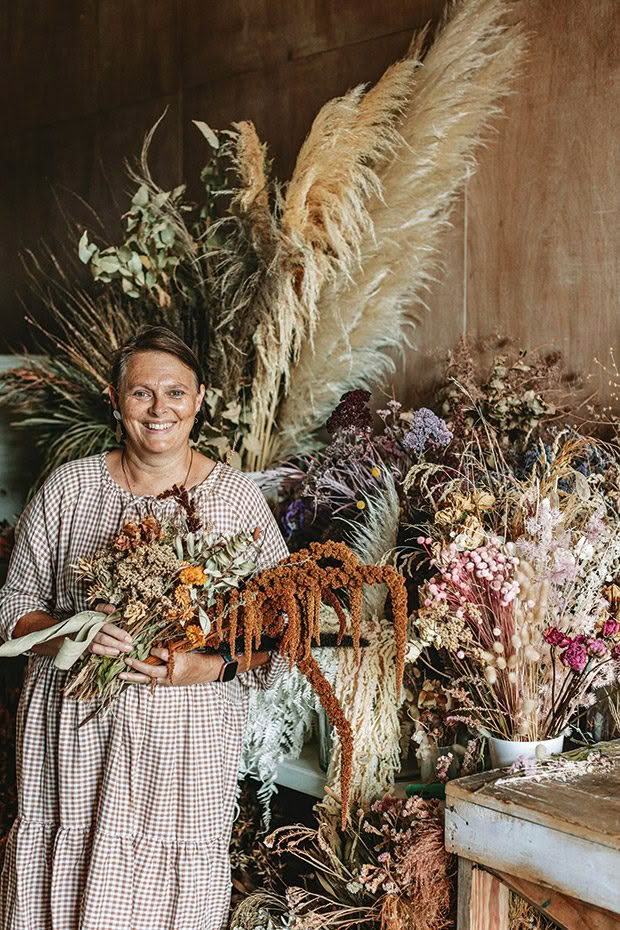
Homegrown eucalyptus, biscuit amaranthus, bottlebrush and wild achillea are among the flowers and foliage used in Karen Gray’s dried bouquet.
A natural phenomenon helped one Tasman woman shake off serious post-op complications and led to a thriving produce and floristry business involving an entire family.
Words: Nicole Barratt Photos: Renee Edwards
Paul and Karen Gray could see that their roadside gazebo, which housed homegrown berries for sale, had a mind of its own. One minute it would be firmly pegged into the soil at the end of their drive near Motueka and in the next it would be gone, a gust of wind sending it cartwheeling and careering down the road.
“Enough is enough,” Karen declared one day over punnet loads of strawberries strewn roadside. The couple eyed up the garden shed and devised a plan to bring sales indoors.
It was only a matter of time before Paul and Karen converted their four-hectare Kina Peninsula property into Garden House, a boutique farm store. “We’ve always done big things, and we’ve never really been fazed by doing them ourselves,” Karen says.
The couple initially farmed barley, sugar beet and potatoes on 121 hectares in Lincolnshire in Britain before a succession of wet harvests in the late 1980s drove them to think of alternatives. A one-day pond management course seemed to offer a solution, especially as they’d always been keen on fishing.
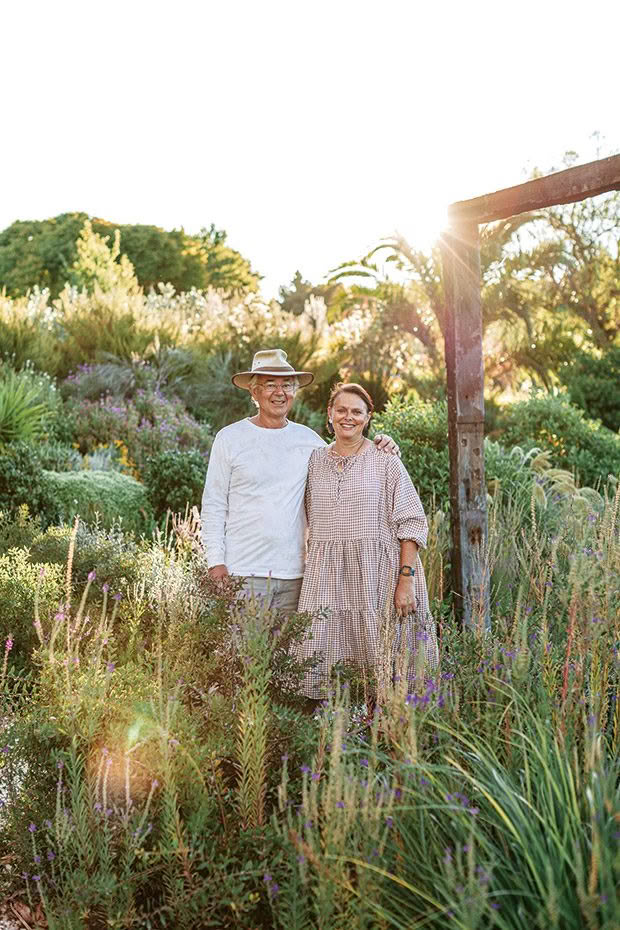
Ake ake, mānuka and corokia are included in the natives that dot Karen and her husband Paul’s garden overlooking Moutere Inlet. They say gardening has kept them fit for life, and they’ve been fitter than a majority of their woofers, who are often shocked at the physical nature of gardening. More than 30 have been hosted in their Motueka home over the past four years. “It’s always rewarding passing on gardening knowledge to people.”
“We decided to dig four lakes and start a fishing lodge,” says Paul. Before long, a truck arrived carrying a tank with 80 trout and thousands of coarse (large-scale freshwater fish such as carp and koi) to be emptied into the newly dug ponds.
Paul and Karen are both green-fingered, and they planted five hectares of land around the ponds with english oaks, wildflowers and bluebells. Wagtail Lodge and Fishery, with its 22 accommodation beds, quickly became popular and was booked solid for 10 months of the year.
“But after a decade of doing laundry and cleaning toilets every week, you start to feel like there could be something more, as much as we loved it,” Karen says.
Aotearoa had always been on their radar; when Paul was backpacking through Australia, he was told New Zealand was the place to live, and Karen has family ties to Ngāti Kahungunu.
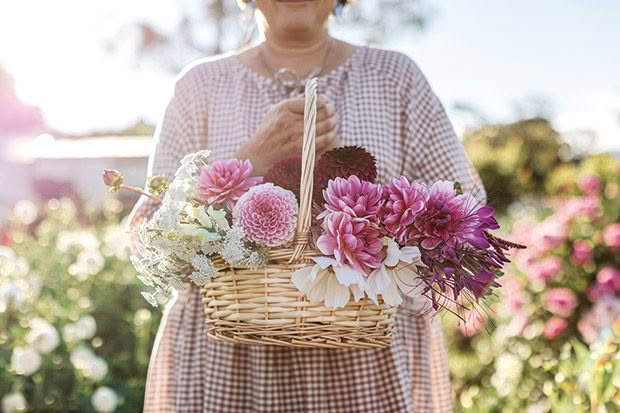
Plane tickets were booked, their home sold, and the lodge left in the hands of family. A shipping container of belongings was packed, including those of their three daughters — Lucilla, Emily and Mollie, all under seven at the time. They arrived in Auckland in 1991 with 11 suitcases and no clear plan.
“We thought, ‘Let’s just get there, and go from there,’” Paul says. But it wasn’t that straightforward. “Being a farmer, I’d brought a couple of guns over and — coincidentally — Bill Clinton was visiting Auckland at the time.” After a container search, Paul was hauled in to explain the guns. “It was a pretty funny arrival to the country.”
The family piled into a campervan, on the lookout for a place to settle. “When you don’t know a country, it’s hard to decide where to set up your life — it’s such a gamble,” Karen says. A month later, they arrived in Nelson and found home.
“Being massive gardeners, we got here and peered over people’s fences. We saw lush gardens, and it felt like paradise.” They bought a home in Stephen’s Bay (close to Kaiteriteri), the deal sealed when the real estate agent mentioned little blue penguins nesting under the garden shed.
“We moved in the middle of summer — it was buzzing — and we went into the local store and asked how many people lived here in winter. ‘Oh, about six,’ was the response.”
Paul and Karen got to work planting out their garden (and half the neighbourhood’s, voluntarily) with kūmara, potatoes, spinach and strawberries to share with the community. It was an idyllic life until a routine operation took an unexpected turn. “It was something that should have been very straightforward, but I nearly didn’t survive,” says Karen.
“I had a massive allergic reaction to the anaesthetic. At the time, I was the fittest I’d ever been, but I came out of it numb from the waist down for three weeks, and it had a major long-term effect on my nervous system.”
Her memory was also impacted — she struggled to remember things, to spell and write. “I just lay on the sofa. I had no spatial awareness; it was like being outside of my body. It took a year to get over, and it was the biggest wake-up call. You don’t know what’s around the corner.”
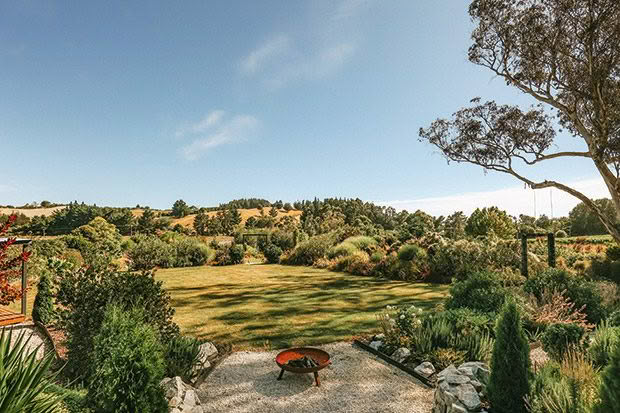
A fire pit has offered plenty of opportunities for toasted marshmallows and stargazing with family.
Four months after the operation, a whale stranding in Stephen’s Bay gave Karen her “epiphany moment”. A rare pygmy beaked whale beached on the sand; Karen hobbled down the stairs to join DOC workers keeping its skin wet with damp bedsheets.
“I rallied neighbours and some builders, who carried it out in a sling to re-launch it into the water.” Saving the whale prompted a realization. “Thinking about something other than myself reminded me that I had a purpose, and I needed to get better.”
Gardening and floristry were central to her rehabilitation. “Growing things and working with flowers was like therapy. I could lose myself in it.” After using hydrangeas, wild carrot and greenery from the garden to help decorate a friend’s wedding, the hobby stuck, the event a springboard to launch a floristry venture, The Wilde Florist.
- “It is so important to save seeds and pass them onto others. It gives us the power to grow what we want, and enables older varieties to thrive and not be lost to future generations,” says Karen.
A knock on the door in 2017 with an offer to buy their home prompted another change. The couple had driven out to the Kina Peninsula a month earlier and eyed up a house on farmland overlooking the estuary.
It wasn’t for sale at the time but, in a strange twist of fate, it belonged to the same person who had knocked on their door. “I get goosebumps when I think about it. We’d been talking about moving, and I had said I would go and knock on their door. It did feel like fate,” says Karen.
The property was a blank canvas, with good soil — Paul checked that out with his spade before signing the deal — and they thought they could grow a variety of natives, flowers and fruit trees organically, without sprays.
- Daughter Emily offers a hand in the shop. She’s a wedding planner in Nelson with Wilde Wedding Design but also makes Garden House bath soaks from dried botanicals grown on the farm and other native ingredients.
Planting was delayed when two cyclones hit shortly after moving in, torrential rain causing flooding on the property. “It took time to get things ready, but that was okay because we wanted to plan things out. We envisioned small pockets of areas divided up like little rooms,” Paul says.
During the country’s first lockdown in 2020, the pair set up their roadside gazebo, stacked with baskets of fresh produce for neighbours. Post-lockdown, with a thriving garden, a mass of produce (and the misbehaving gazebo often missing), Paul and Karen decided to create a space in a garden shed.
“It was dirty and full of farm rubbish but lining the roof to create a ceiling and applying a fresh lick of paint did the trick. We wanted to create a space for people to come for a coffee, pick up produce and enjoy the garden.”
- The summer months see hoards of locals and visitors to the Tasman region stock up on Garden House’s summer berries.
- “The berries and a cup of coffee [in the onsite café] are always a big hit, but we have plenty of other homegrown produce and plants on offer, too,” Karen says.
Karen is the head barista, trained by local coffee expert Fox Slotemaker (of Rabbit Island Coffee Co). The couple’s now-grown-up daughters also played a role in setting up the business: Lucilla took charge of designing a website, Mollie photographed the new premises, and Emily brewed botanical oils to sell. Garden House opened in September 2020.
“It grew in popularity fast; we didn’t expect it. We’re trying now to get all our planting and heavy jobs done in winter so we can focus on the shop in summer.” A fair amount of organization is needed to manage the garden, the manning of the coffee machine and local flower orders, trimmed and transformed in an adjacent shed. A morning checklist each day keeps Paul and Karen on track.
“You don’t really get any time off with this sort of thing, but the garden is our happy place. I remember as a kid my dad saying: ‘We can’t go on holiday until we’ve got this sugar beet weeded,’ so I guess I’m used to it, too,” Paul says.
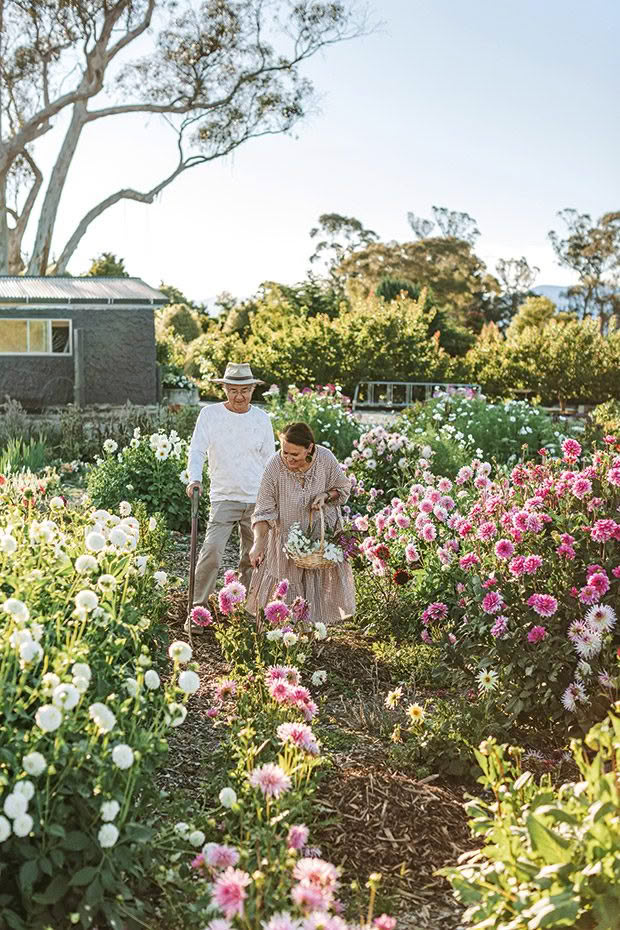
Karen’s bouquets use flowers cut from her garden. “I love mixing in native foliage. Sometimes there are 30 different things in a bouquet. Red mānuka dries beautifully, so I often put that in.” She isn’t formally trained as a florist, and likes it that way. It makes her work flow more freely, she says.
Often Karen will realize she hasn’t left the house in days. “I could wander around forever just playing with the plants and flowers, from dawn to dusk each day. There is so much joy to be found in the soil.”
“But you can only do what you can do, work-wise,” Karen adds. “We’ve stopped setting ourselves strict deadlines — it has to be like that, or you start having accidents.” Recently Paul fell through a window, forgetting he’d moved his step ladder. “When that happens, you put the tools down for a day. It’ll still be there tomorrow. And if it’s a weed, it’ll be there, just twice as big.”
SEEDING A PASSION FOR GARDENING
Paul and Karen’s love of gardening is rooted in family. Karen’s father was in the British armed forces, and when posted to Singapore, she’d watch her mum arrange orchids picked from their garden. Paul spent much of his childhood with his grandparents in Lincolnshire.
- The couple’s blackberries — a variety called ‘Black Satin’ ripening; silverbeet growing.
- Gardening is a learning curve, Paul says. A hydroponics system was delivered with no instructions and the wrong fittings last year, but Paul and Karen managed to put it together, and now their strawberries grow faster than they can keep up with..
“They had half a hectare of walled gardens and a glasshouse. When they first bought the place in 1947, there were eight gardeners, including a head gardener who came to work with white kid gloves and said he only worked in glasshouses. It’s safe to say he didn’t last very long.” Six-year-old Paul was interested enough to ask the gardeners how to take cuttings from chrysanthemums.
WILDE FLORIST WORKSHOPS
Karen has held several floral workshops in her garden shed over the years through her business, The Wilde Florist. “I’ve loved passing on my tips and knowledge to others in the community. It’s a lovely way for people to connect creatively and come away having learnt a new skill.”
- Streptocarpella saxorum (false african violet).
Workshop topics have ranged from table arrangements and bouquet styling to floral-crown tuition. “I think it’s amazing that in every workshop I do, everyone comes away with their own interpretation and unique design — not one looks the same. It is my version of painting but with flowers.”
Karen has been dreaming of a permanent space to hold these workshops, and last year a large shed adjacent to their café was transformed into a calm floral haven after a good clear-out and a coat of white paint.
GROWING GARDENS
Often people see a thriving garden and forget the work behind it. “It’s the problems you don’t see, like deficiencies in plants — particularly, boron and magnesium in this area. It’s common in land used as farmland, so we spent a fair bit of time putting gypsum in the soil.”
Sometimes crops expected to thrive struggle, Karen adds. Boysenberries thrived one year then dried up after contracting a fungus. “We were preparing for half a tonne and ended up with none.” Keeping things organic, they spray their plants and roses with diluted apple cider vinegar — it works a treat on fungus.
Love this story? Subscribe now!
 This article first appeared in NZ Life & Leisure Magazine.
This article first appeared in NZ Life & Leisure Magazine.
